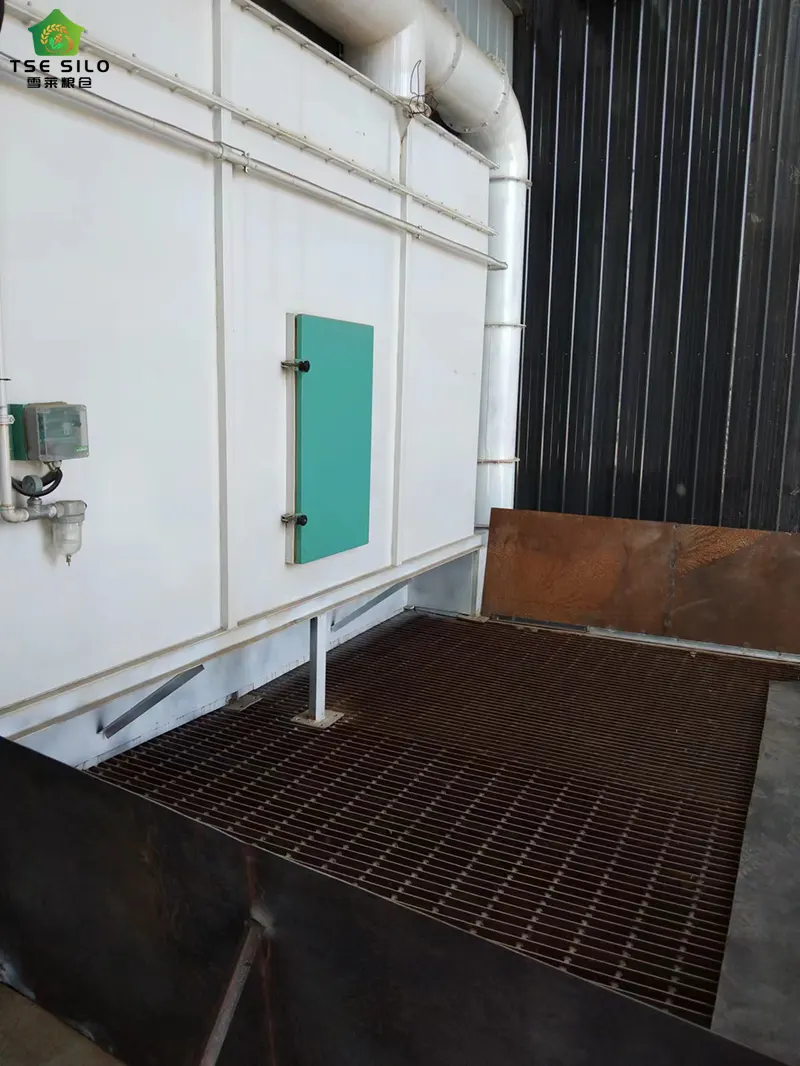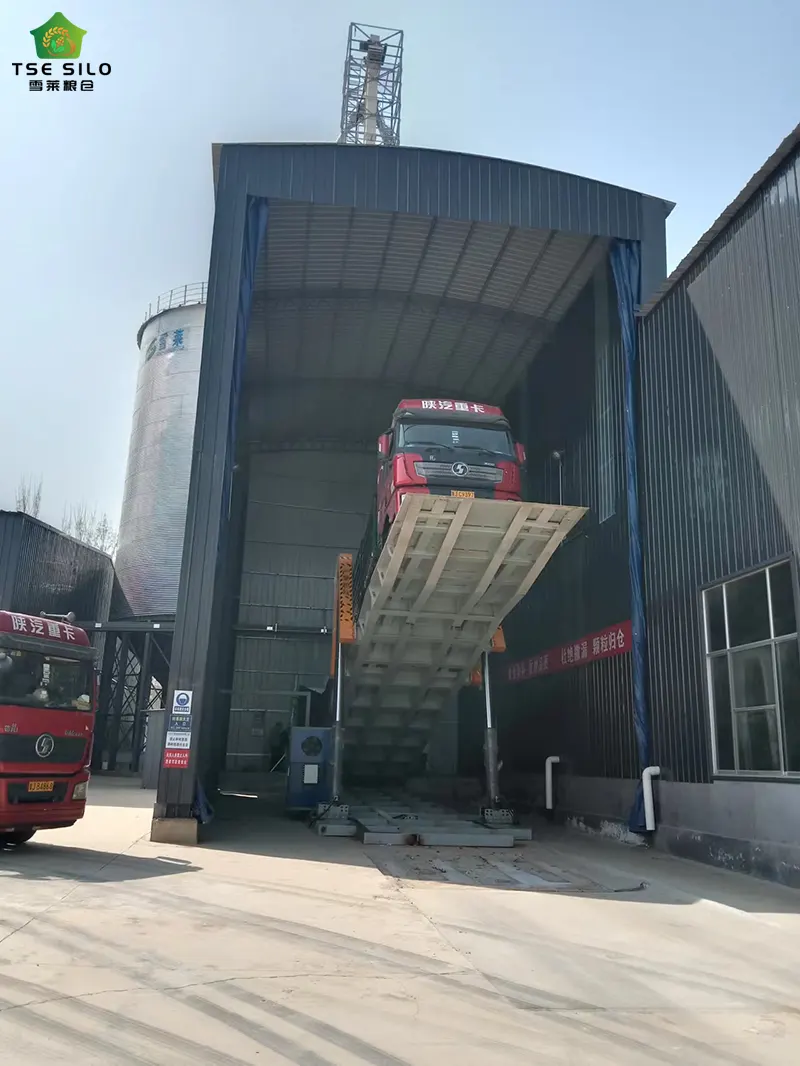In the efficient grain storage system, the system that truly improves the storage efficiency is the in and out system. The efficient in and out system can not only ensure the time of grain in and out of the warehouse, but also provide protection for grain safety. In the entire in and out system, there are many machine components and the various components need to work together to ensure the normal and efficient operation of the entire system. Therefore, if you want an efficient in and out system, you need to optimize it from multiple aspects such as hardware equipment, process flow, automation level and operation and maintenance management. Today we will take a closer look at the relevant strategies and optimization measures to improve the efficiency of grain steel silo in and out.
I. Hardware equipment optimization
Efficient feeding system:
For the feeding system, we generally choose the most suitable feeding system according to different storage materials. Each feeding transmission method has its own suitable grain storage. After determining the feeding transmission method, if the cost operation is changed, we should adopt a multi-point feeding method to improve efficiency. Let's take a closer look.
Choose suitable conveying equipment:
Choose the most efficient conveying method according to the material characteristics (particle size, fluidity, abrasiveness, density).
- Pneumatic conveying: Suitable for powdery and small-particle materials, can be transported over long distances, at multiple points, and flexibly, but the energy consumption is relatively high and the material may be broken.
- Belt conveyor: Suitable for most granular and block materials, with high efficiency, good continuity, and relatively simple maintenance.
- Scraper conveyor: Suitable for occasions with large dust, poor fluidity, or multi-point unloading, with good sealing, but high power consumption and wear.
- Screw conveyor: Suitable for powdery, small-particle or sticky materials, with good sealing, but limited conveying distance and efficiency, and easy to wear.
- Bucket elevator: Suitable for vertical lifting of granular and block materials, with high efficiency.
Design and optimization of feed inlet:
You can design the appropriate number of feed ports according to the tonnage and cost budget of your own steel silo, so that multiple feed ports can run simultaneously to maximize the feeding speed.
- Multi-point feeding: Set multiple feed ports on the top of the silo, cooperate with a distributor or a rotating distributor car to make the material more evenly distributed in the silo, reduce the time of flattening operation, and increase the single feed amount and speed.
- Feed port optimization: Ensure that the feed port size is large enough and smoothly connected with the conveying equipment to reduce blockage and dust.
- Efficient dust removal: A large amount of dust will be generated during feeding. Equipped with a dust collector with sufficient air volume and filtration efficiency, maintain a negative pressure environment, ensure a clean working environment and smooth system.
Efficient discharging system:
Optimize the design of the unloading cone bucket:
In the discharging system of the grain steel silo, high efficiency is always the primary data for evaluating its performance indicators. When we design the discharging system of the steel silo, we generally start from two aspects to solve this problem, that is, we often say that we can increase the discharging speed and increase the discharging port. Let's explain it in detail below.
- Cone bucket angle: It must be greater than the repose angle of the material to ensure that the material flows smoothly by gravity. Materials with poor fluidity require a larger angle (usually ≥65° is recommended).
- Smooth inner wall: Use high friction coefficient, wear-resistant materials (such as stainless steel lining, polymer wear-resistant plate) or special coatings to reduce material wall hanging and friction resistance.
- Shape optimization: Avoid sharp corners and use parabolic or hyperbolic cone buckets to promote the flow of the center of the material.
Reliable activation/arch breaking device:
- Pneumatic arch breaking: Install air cannons, fluidizing rods, inflatable boxes, etc. at key parts of the cone bucket, and use compressed air to instantly release energy or continuous airflow to loosen the arched materials. This is the most commonly used and effective method.
- Mechanical arch breaking: Install vibrators (silo wall vibrators, cone bucket vibrators), mechanical agitators or arch breaking arms. Pay attention to the impact of vibration on the silo structure and the potential damage of the agitator to the material.
- Vibrating bottom cone: The entire discharge cone bucket is designed to vibrate to promote the overall flow of materials.
Efficient discharge equipment:
- Large flow discharge port: The discharge port size is as large as possible.
- Choose suitable feeding equipment: such as vibrating feeder (efficient, uniform, easy to control), rotary feeding valve (with both air lock and metering functions), impeller feeder, large gate, etc., to ensure continuous, stable and controllable discharge.
- Discharging conveying equipment: The conveying capacity of the subsequent conveying equipment (belt conveyor, scraper conveyor, screw conveyor, etc.) connected to the discharging port must be greater than or equal to the maximum capacity of the discharging equipment to avoid becoming a bottleneck.
- Multi-point discharging: For large grain steel silo, multiple discharging ports can be set at different heights of the cone bucket, or a ring-shaped multi-point discharging structure (such as a ring-shaped scraper conveyor for grain) can be used to increase the discharging channel and improve the overall discharging rate.


II. Process flow and management optimization
First in, first out (FIFO):
Design a reasonable material flow path to ensure that the first material in the warehouse is discharged first. For a single warehouse, the vertical flow of materials can be guided by a central pipe or a multi-point discharging design to avoid "dead material areas". For multiple warehouses, do a good job of inventory rotation management.
Reduce the frequency of clearing warehouses:
- Through optimized design (cone bucket angle, inner wall smoothness, arch breaking device) and fine management (control of material moisture, impurities, storage time), minimize material residue and compaction, and extend the effective clearing interval.
Efficient warehouse clearance plan:
- When warehouse clearance is necessary, equip safe and efficient warehouse clearance equipment (such as special warehouse clearance machines, robots) and plans to shorten the warehouse clearance time and reduce the risk and intensity of manual operations. Strictly abide by the safety regulations for confined space operations.
Refined inventory management:
- Establish accurate inventory ledgers, grasp warehouse information in real time, optimize inbound and outbound plans, and avoid equipment congestion or idleness caused by centralized inbound and outbound.
III. Automation and intelligent upgrade
Automation control system:
- Integrated control (DCS/PLC): Incorporate conveying equipment, feed valves, distributors, arch breaking devices, discharging feeding equipment, dust collectors, etc. into a unified automation control system. Realize one-button start and stop, sequential control, and interlock protection.
- Material level monitoring: Install reliable and accurate material level meters (radar, heavy hammer, ultrasonic, radio frequency admittance, etc.) to monitor the material height in the warehouse in real time, and realize high and low level alarms and automatic start and stop control.
- Flow monitoring and metering: Install belt scales, punch plate flow meters, nuclear scales, etc. at key inlet and outlet points to achieve accurate metering and flow monitoring of in-and-out materials.
Warehouse management system:
Implement WMS system, integrate with production system and logistics system, realize digitalization and intelligence of inventory management, operation scheduling, and document flow, and optimize operation instruction issuance and route planning.
Remote monitoring and diagnosis:
- Establish SCADA system or cloud platform-based monitoring center to realize remote real-time monitoring of equipment operation status and key parameters (current, temperature, vibration, material level, flow), historical data tracing, fault warning and remote diagnosis, and improve operation and maintenance response speed.


IV. Operation and maintenance management optimization
Preventive maintenance:
- Formulate and strictly implement equipment inspection, lubrication, and maintenance plans, especially for conveying equipment, bearings, reducers, arch breaking devices (air cannon diaphragms, fluidizing rod breathable layers), dust removal filter bags and other key wearing parts for regular inspection and replacement to avoid sudden failures affecting efficiency.
Personnel training:
- Provide professional training for operators and maintenance personnel to enable them to master equipment operating specifications, process flow, common fault handling methods and safety regulations, and improve their operating proficiency and emergency handling capabilities.
Spare parts management:
- Reserve a reasonable inventory of key wearing parts to shorten the waiting time for fault downtime.
Summary of key points
- The core is fluency: Ensure that the entire path of materials from entering the warehouse to leaving the warehouse is as smooth and unobstructed as possible. The focus is on the optimized design of the unloading cone bucket and reliable arch breaking activation measures.
- Matchability: The equipment capacity (transportation capacity, feeding capacity) of each link must match or even have a slight surplus to avoid bottlenecks.
- Automation: Automated control is a key means to improve efficiency, reduce manual intervention, and ensure safety and stability.
- Informatization: Realize data transparency through systems such as WMS and SCADA to support fine management and intelligent decision-making.
- Predictability: Reduce unplanned downtime through preventive maintenance and condition monitoring.
- Safety: All efficiency improvement measures must be carried out under the premise of ensuring the safety of personnel and equipment, with special attention to risks such as dust explosion prevention, confined space operations, and mechanical injuries.
The final selection of optimization measures requires comprehensive evaluation and solution design based on specific material characteristics, inbound and outbound frequency, existing facility conditions, investment budget and other factors. Usually, an efficient system is a combination of hardware upgrades, automation investment and lean management.
Written by
Shandong Shelley Grain Steel Silo Co., Ltd
Editor Jin
www.grainstoragesilos.com
WhatsApp : +86-18653877118
Email : shelley@cnshelley.com






